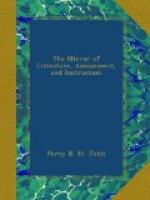The general colour of the upper plumage is light hair-brown, mottled and variegated with dark umber-brown and yellowish-white. The under plumage is white and unspotted on the breast and part of the body; but dark umber-brown, approaching to black, on the lower hall of the body, and part of the flanks; the latter towards the vent are marked as on the upper plumage. The under tail coverts are black, broadly tipped with white. The feathers of the thighs and tarsi are light hair-brown, mottled with darker lines. The throat and region of the head is varied with blackish on a white ground. The shafts of all the feathers on the breast are black, rigid, and look like hairs; but those of the scale-like feathers of the sides are white and thicker. The bill and toes are blackish. The bill is thick and strong: the ridge is advanced to a remarkable extent towards the front, and divides the thickset feathers which cover the nostrils by a convex ridge of three quarters of an inch long. This is a very peculiar and important character, since it plainly indicates the analogy of this form to Ramphastos, Buceros,[5] and numerous other rasorial types. On each side the breast, the present specimen exhibits two prominent naked protuberances, as in the female bust, perfectly destitute of hair or feathers. On each side of these protuberances, and higher up on the neck, is a tuft of feathers, having their shafts considerably elongated and naked, gently curved, and tipped with a pencil of a few black radii; they are placed much behind the naked protuberances, and do not appear intended to cover them when not inflated. On the sides of the neck, and across the breast, below the protuberances, the feathers are particularly short, rigid, and acute, laying over each other with the same compactness and regularity as the scales of a fish, excepting that their extremities are not rounded, but acutely pointed. Lower down the breast these feathers, however, begin to assume more of the ordinary shape; but the shafts still remain very thick and rigid, while each is terminated by a slender, naked filament, hornlike, shining, and somewhat flattened towards the end, where there are a few obsolete radii. The wings in proportion to the size of the bird, are very short; the lesser quills ending in a point. The tail is rather lengthened and considerably rounded, each feather lanceolate, and gradually attenuated to a fine point. The tarsi are somewhat elevated, thickly clothed with feathers to the base of the toes, and over the membrane which connects them. The length of this bird Mr. Swainson thinks to have been 25 inches. The female bird, it should be added, has neither the scale-like feathers nor projecting shafts of the male.




